How Laurel Truscott made Outside sing
Shapes, senses, colour
(9 minute read)
Optimistic birdsong, uplifting pops of yellow, the nectar-rich scent of newly flowering shrubs. Spring’s resurgence contrasts starkly with the conditions landscape architect Laurel Truscott faced when realising her designs for Outside on a boggy and bitterly cold site back in January 2022.
But far from being deterred, Laurel embraced the challenge. Using her skills and experience, passion for biodiversity and multisensory approach, she has transformed the space into a sanctuary of seasonal scents, shapes and colours.
As Outside emerges from winter once more, Laurel takes us on a wander around the grounds – reflecting on the process, what she loves about the gardens right now, and her hopes for how they’ll continue to grow.
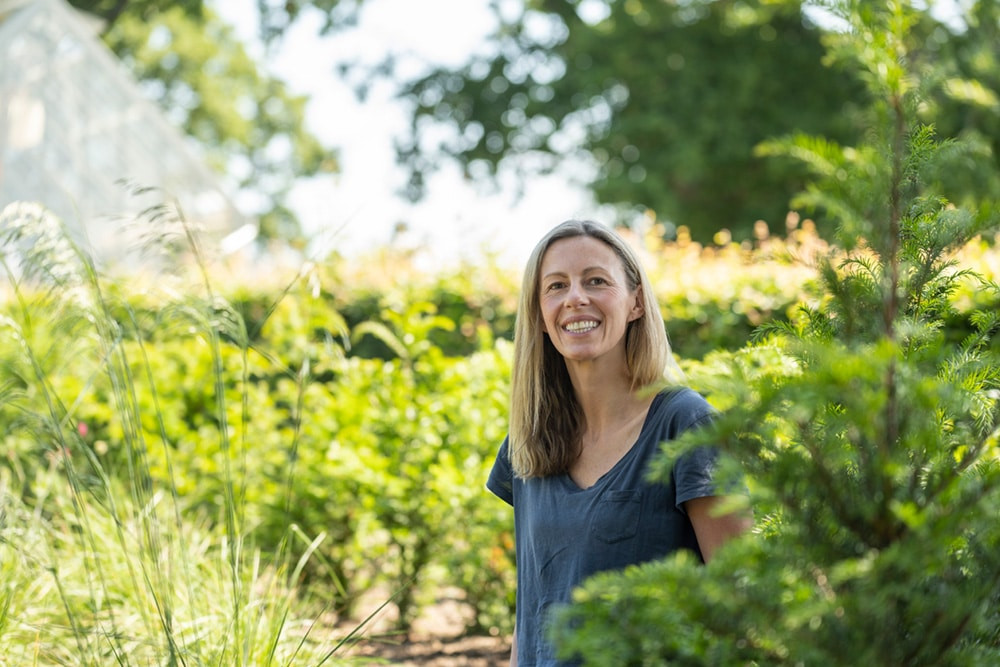
When we first started work on Outside, it was very wet and wintery, which meant we had to be quite adaptable, responding to challenges as they came up. It went from a bit of a quagmire to this beautifully contoured space with sweeps of grasses and shaped hedges and vertical planes with trees.
I’m thrilled that the gardens continue to grow, flower and change through the seasons to create this beautiful, colourful, sensory experience year-round.
It’s wonderful to see how far the planting has come and how happy the plants are. James, the head gardener, has done a fabulous job and they’re flourishing. Some had a slow start, like the Cornus 'Midwinter Fire', but their burnt orange stems have been particularly stunning this winter and create the perfect permeable screen around the shepherd huts.
The ornamental grasses have established well and look striking throughout the seasons. In summer, you see their arching green fronds with the tall blue flowers of the Verbena Bonariensis and the yellow Rudbeckias. Autumn and winter bring sculptural gold fronds with tall black seedheads.
There are so many garden highlights for guests to look out for this spring. We planted a huge number of bulbs last year and I’m so excited to see them emerge. There are daffodils, including my favourites, the pure white scented Narcissus 'Thalia'. Then there are great drifts of green, white and dark pink tulips, and tiny blue chionodoxas planted beneath the many hydrangeas.
Camellias, primulas, hellebores and daphnes will all be in flower come spring – along with the fruit trees, magnolias and some of the rhododendrons – and you’ll see the leafy green buds of the hydrangeas about to burst forth. The yellow flowers of the Mahonia 'Winter Sun', which are so beautifully scented, may still be holding on too.
We picked lots of blues and yellows to encourage the bees, and perennial and annual wildflowers to create waves of colour. We’re really thinking about the seasons through the year and how it will cycle for maximum impact.
There are so many garden highlights for guests to look out for this spring – great drifts of green, white and dark pink tulips, and tiny blue chionodoxas planted beneath the many hydrangeas…
As well as the visual look of the space, it was important to me to incorporate other senses. Wherever there’s an intersection of paths, or you cross from one threshold into another, we’ve planted gorgeous scents to elevate the experience.
We have the daphne and mahonias in the winter, with their wonderful vibrant woodland scent, and spring into the summer with lavender and rosemary around the Glasshouse and down the steps. Outside each of the shepherd huts, we have scented flowers that give a waft whenever guests open their doors, and we’ve also planted sarcococca and scented rhododendrons.
Then there are the sounds; the rustle of grasses, the swish against your body as you walk through the wildflower meadow. It’s all part of the design.
Spring is the best time for noticing colour and scent, like the honeysuckle in the native hedges. We’re outdoors more and our sense of smell seems to come alive with the change in weather. The daphne Bhloua Jaqueline Postill which we planted next to the shepherd huts and along paths smells divine, and has these delicate pink and white flowers which pop out before much else is happening in the garden.
Encouraging biodiversity and wildlife was a key focus of my designs for Outside, and the garden is host to a huge variety of plants that bees (both long and short-tongued), butterflies, insects and birds love. There’s catmint, which is constantly surrounded by the buzz of intoxicated bees, geranium 'Rozanne', lavender, thyme, helenium, and honeysuckle – plus all the herbs that James grows in the kitchen garden.
We try to provide habitat and shelter for insects and birds by leaving the ornamental grasses and seedheads for as long as possible throughout winter. And our wildflower meadows – which will be starting to come to life again this spring – feature an established native perennial wildflower mix, overseeded with an ornamental seed mix in March or April, to provide an important home for wildlife.
I’m always keen to minimise waste. For example, when we were creating the gardens, we found these lovely yew domes which we’ve replanted across the site and some of them have really flourished in their new spots. I love doing that in a garden, giving plants a new lease of life rather than throwing them away.
Guests are really interested in what we’re doing in the gardens. Many of them want to replicate planting combinations/approaches and learn more about biodiversity and attracting wildlife in their own gardens. I’ve loved seeing and hearing their reactions as they’ve watched the site transform over the last few years. It’s been a really rewarding project.
We aren’t finished yet either! We’re continuing to plant up new areas around the hotel, and it’s so satisfying to be involved in enhancing the gardens and surrounding meadows for the future.
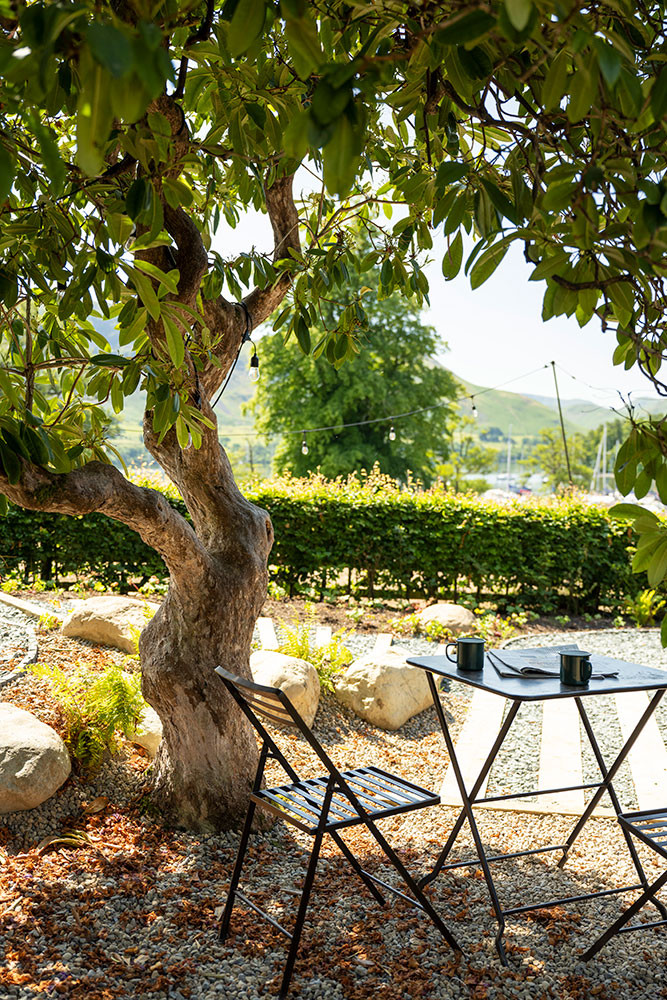
Sitting spot under the old gnarled Rhododendron, which was discovered amongst a mass of shrubs and brambles. The Rhododendron flowers are a riot of delightfully bright pink in Spring with large matt evergreen green leaves atop a sculptural trunk throughout the rest of the year. Ferns (Polystichum setiferum) unfurl from the gaps between large, rounded, re-sited stone boulders. We’ve positioned one of the shepherd huts so that when you open the doors, you’re greeted by this incredible tree. It’s a magical spot; like a secret space all to itself.
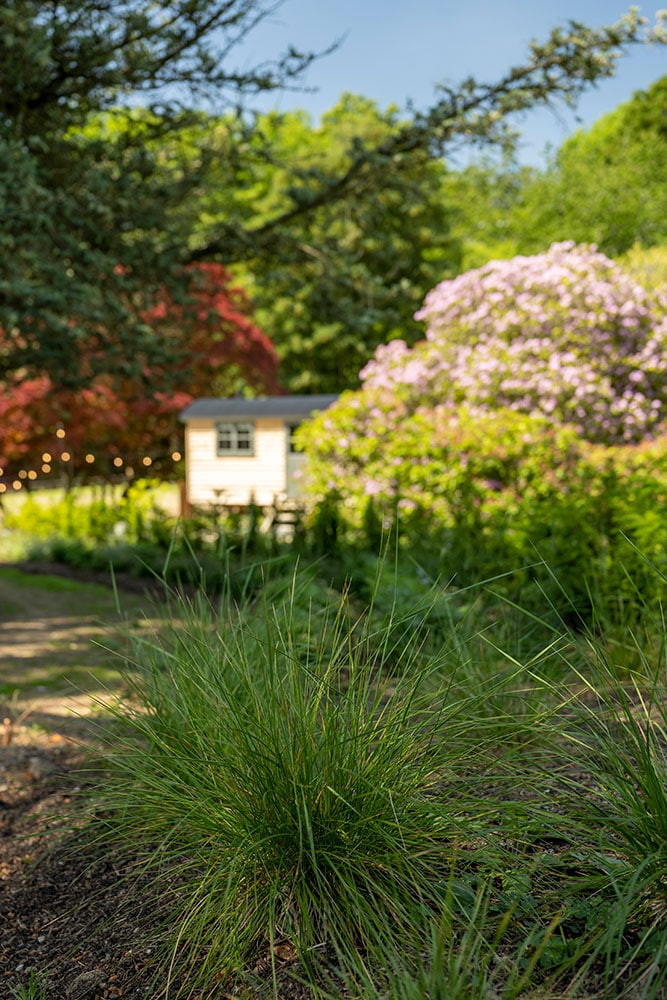
Informal swathes of grasses (including Deschampsia, Pennisetum and Miscanthus) provide continuity across the gardens. Here, the newly emerging Deschampsia cespitosa ‘Goldtau’ bears densely tufting evergreen foliage from which tall feathery flowerheads of silvery purple will appear in summer, eventually turning to a shimmering golden cloud in winter.
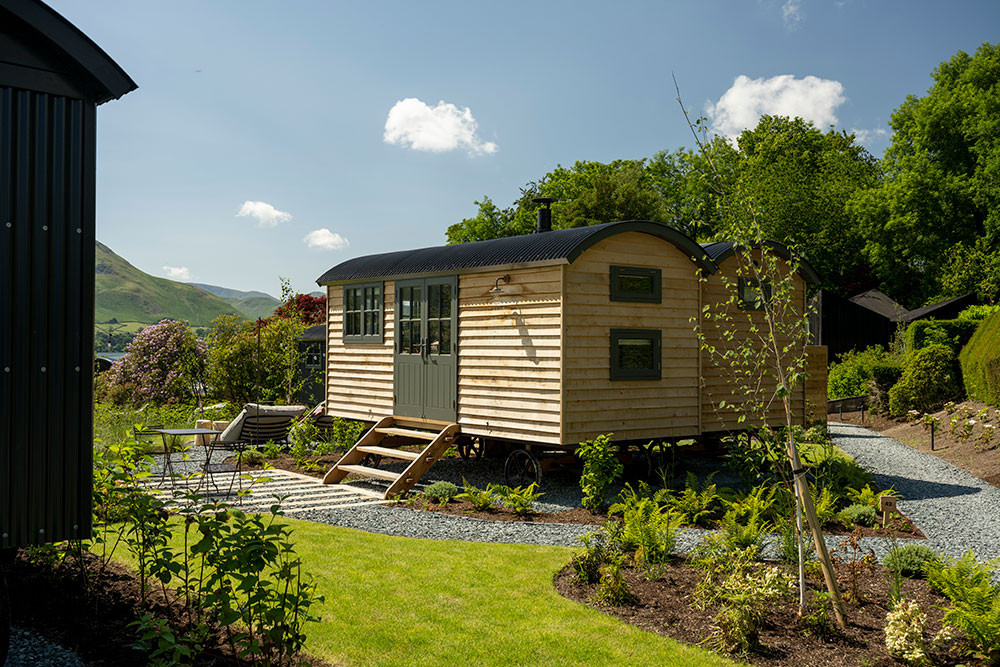
Curving paths, circular terraces and private lawns with individual planting themes, including Ferns, evergreen shade-loving Camellias and bright pink Primulas. The dazzlingly white stems and delicately branching habit of Betula utilis var. ‘Jacquemontii’ forms a linking theme throughout the gardens.
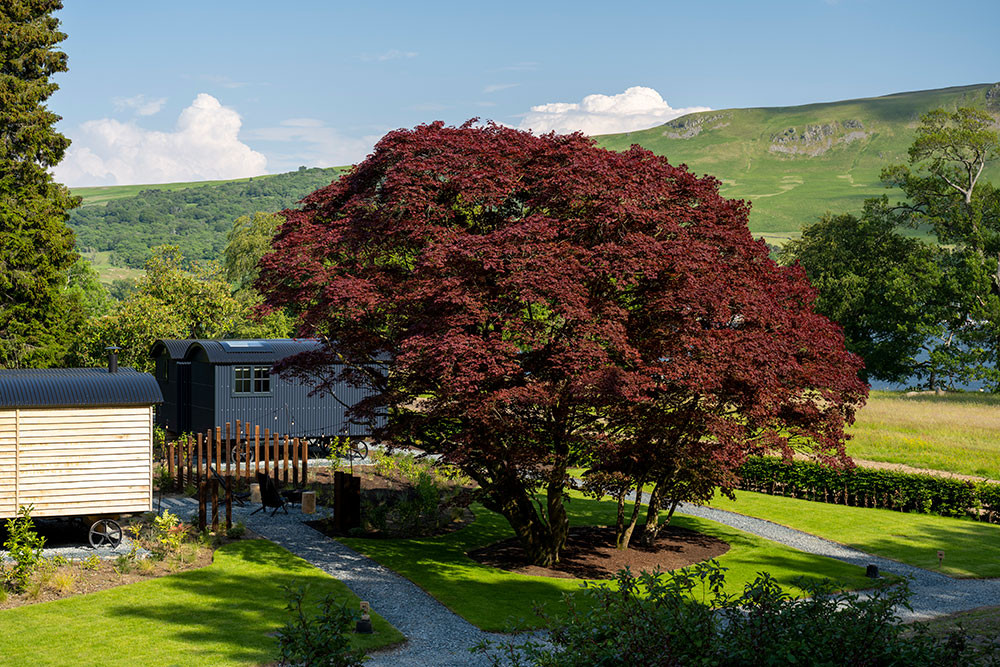
Group of beautifully elegant Acers, planted in the 1950s, provide a dramatic setting for these shepherd huts.
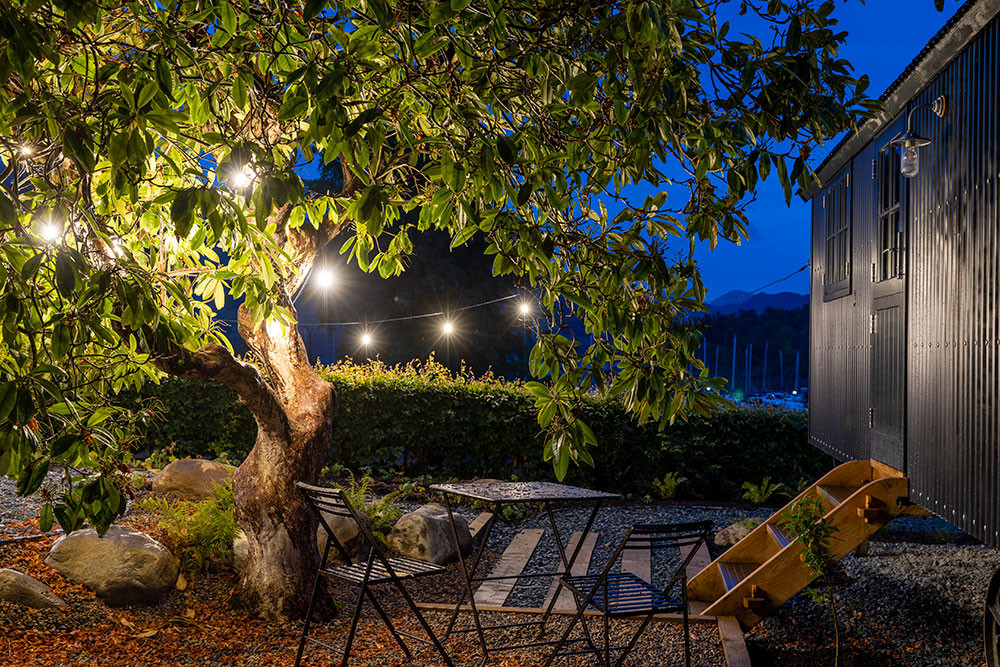
Nocturnal joyous seclusion under the sculptural Rhododendron tree. In winter, a heavenly fragrance will emerge from the pinky white clusters of flowers on the evergreen Daphne (D. bhloua ‘Jacqueline Postil’), planted next to the entrance to the shepherd hut.
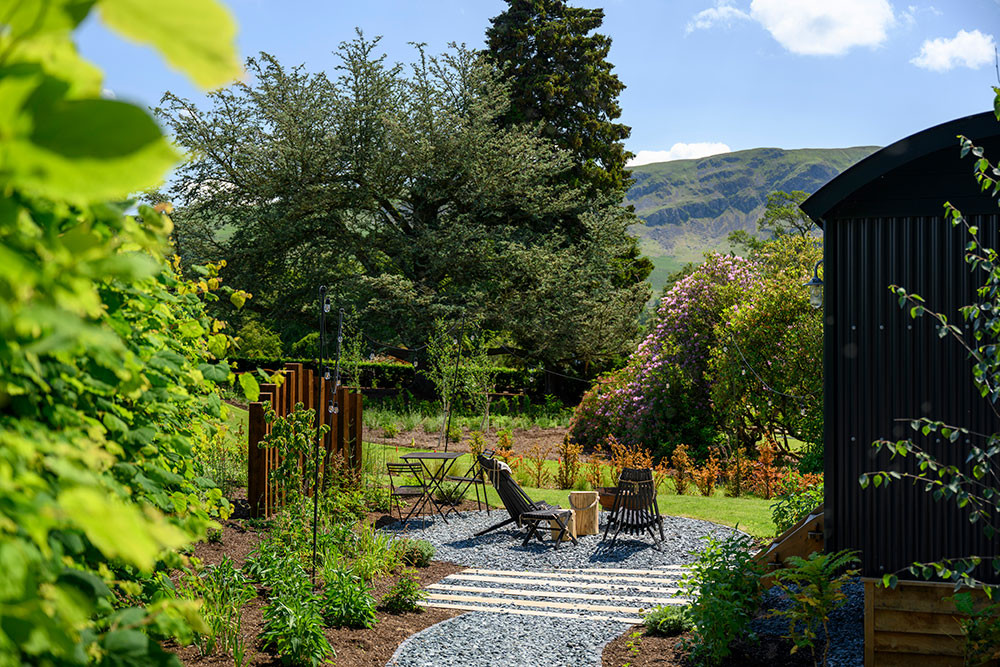
Screened sitting area with views across the gardens to the lake and fells. Hebe topiaria balls will grow to form soft mounding ‘accents’ where edges and materials meet. Where a group of Mahonia media ‘Winter Sun’ are planted adjacent to the shepherd hut entrance, the bright yellow flowering spikes will provide a heavenly scent throughout the winter months.
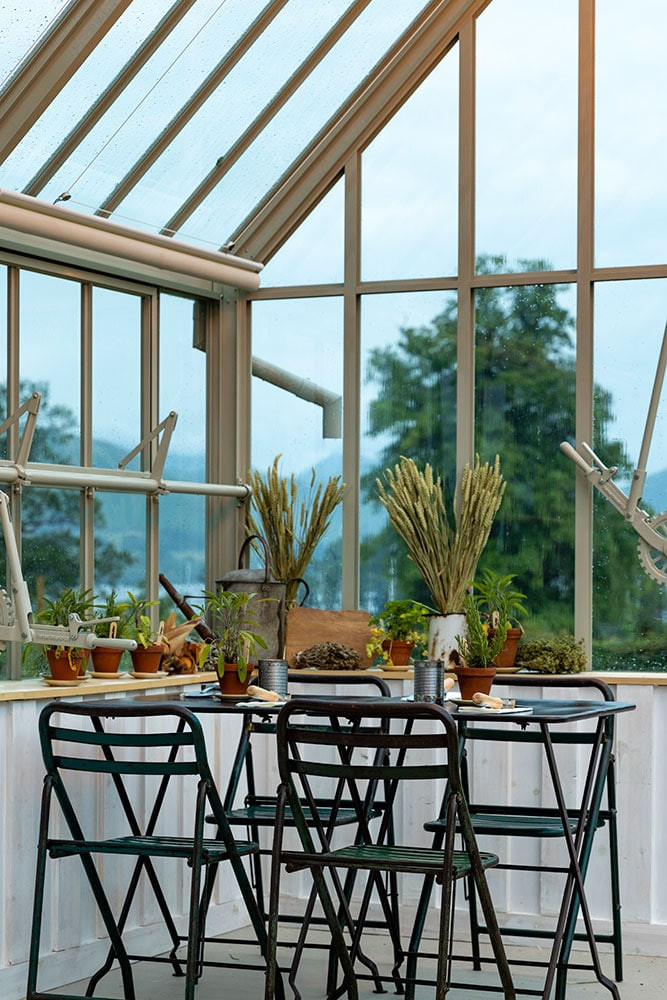
Inside the Glasshouse. Pots of herbs include Thyme, Sage, Mint, Rosemary and Oregano. Outside, mounds of scented Lavender and Rosemary edge the terrace.
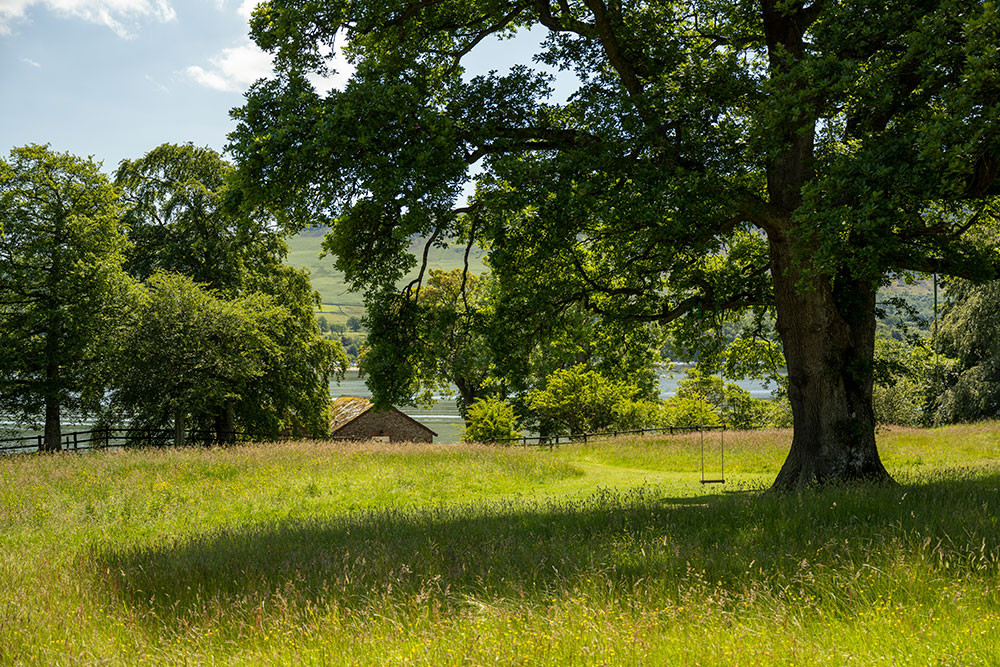
Wide mown paths through the gorgeous big wildflower meadow linking the gardens and Ullswater Lake.
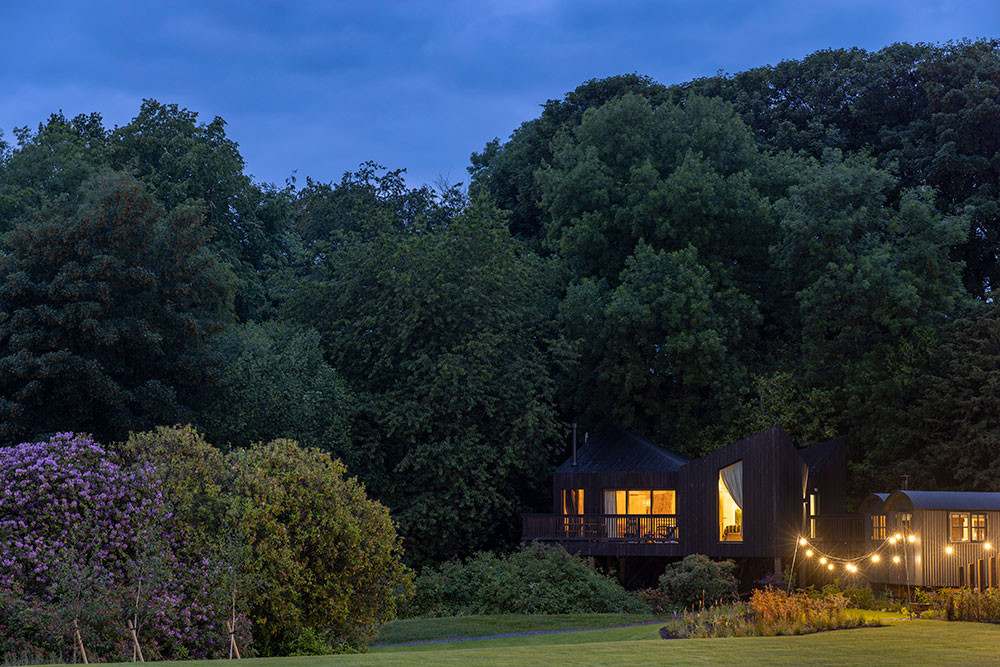
Treehouse peeping out from amongst the surrounding mature trees at dusk. Drifts of red and yellow Kniphofia caught by the lights.
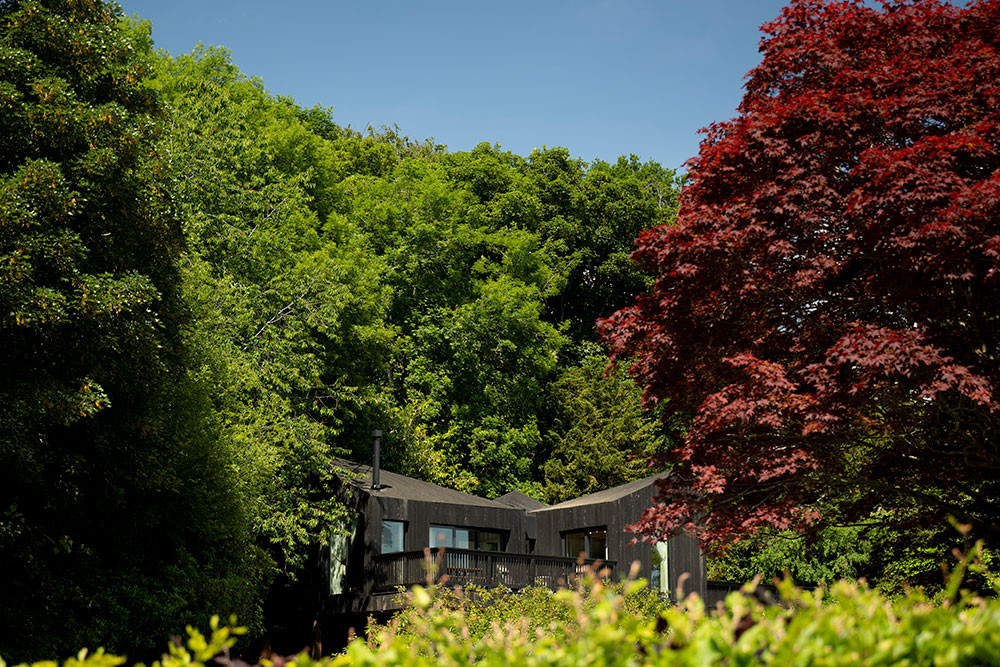
Treehouse nestling amongst the mature trees. View from the meadow.
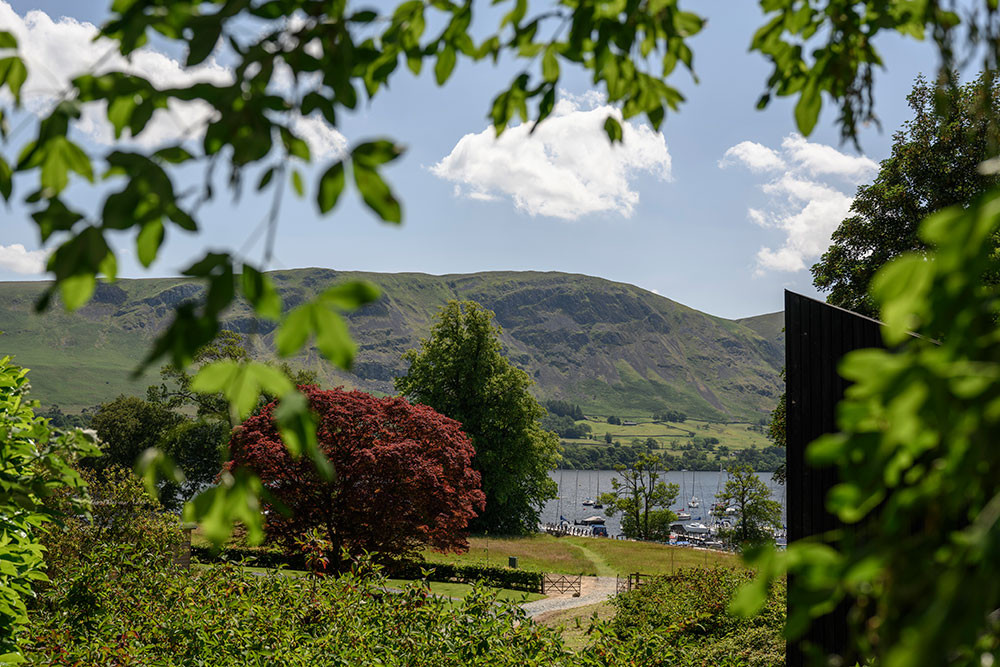
View from the entrance to the treehouse across the boatyard, lake and fells.
Book to stay in a shepherd hut or the treehouse and experience Outside and Laurel’s garden for yourself.